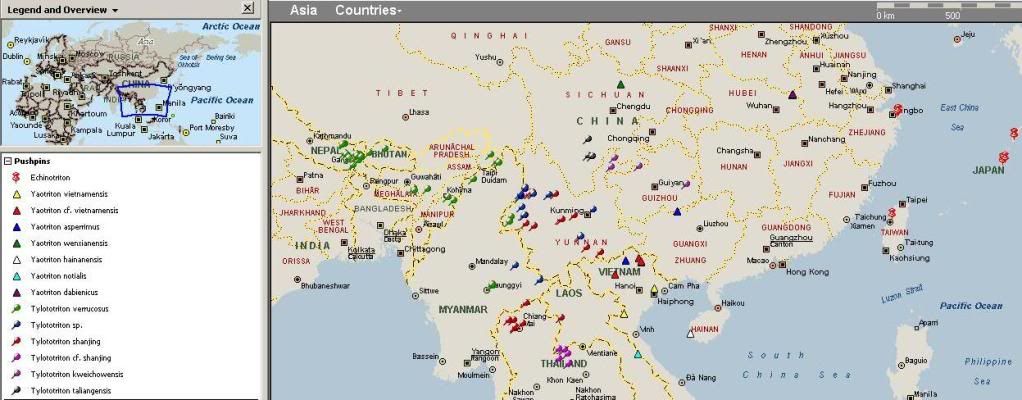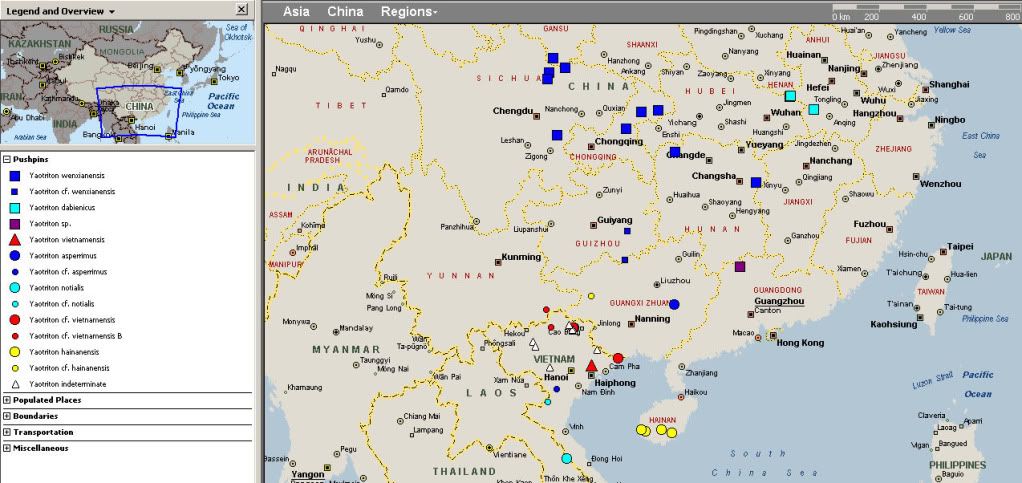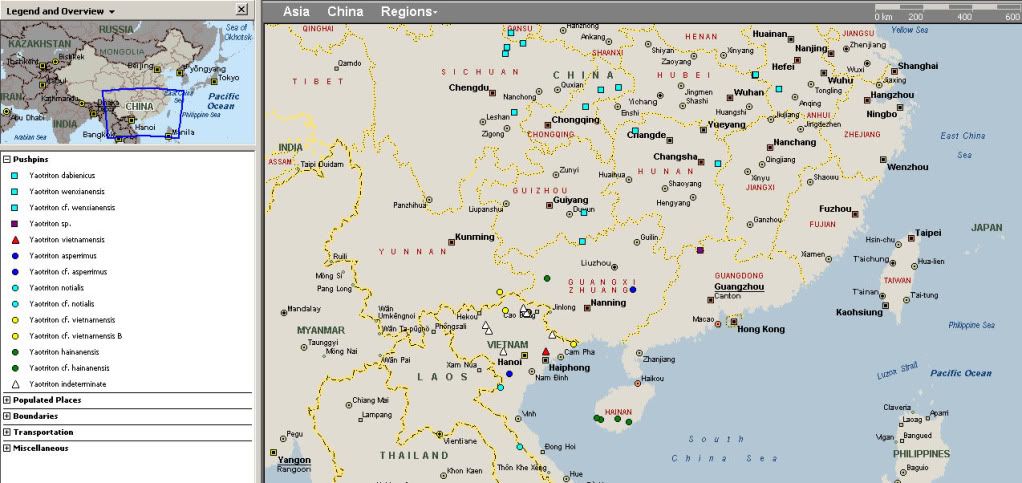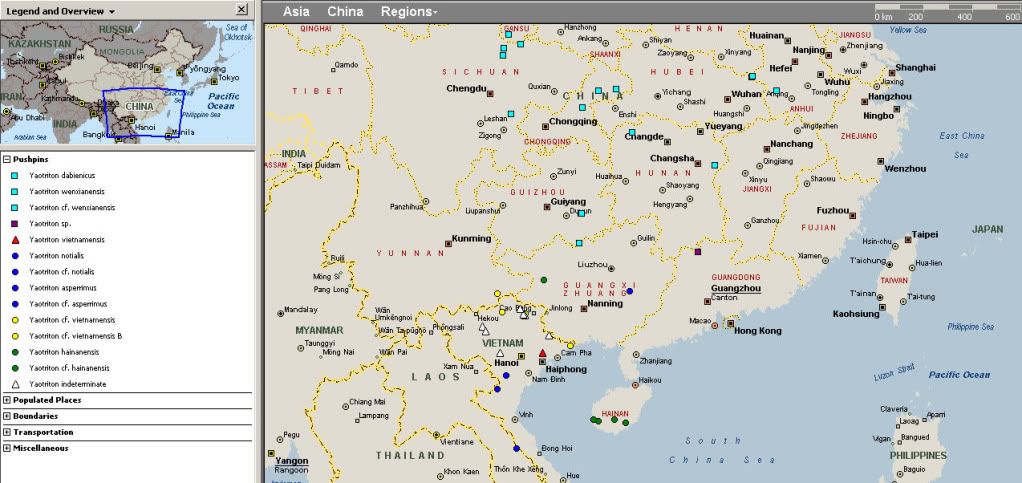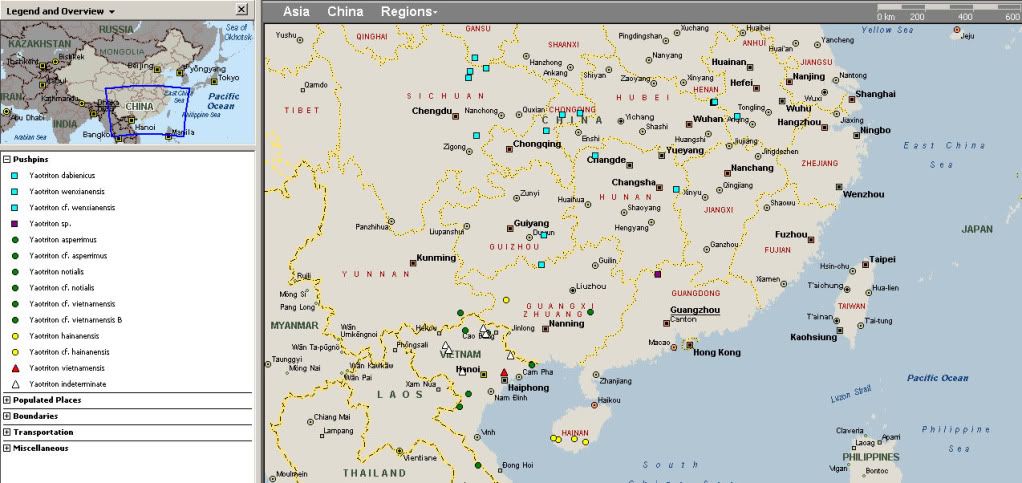FrogEyes
Active member
Sorry, this probably isn't what you were hoping for...
A revision has been published, which evaluates many populations of subgenus Yaotriton, from across their known range in Laos, Vietnam, and China. This is the first study to incorporate all taxa including type localities [save one named this year], and the first to cover a large number of localities. Three mitochondrial genes were the focus of study. Tylototriton dabienicus is not included by name (more on that later).
The authors recover three primary branches which correspond to subgenus Tylototriton, T.vietnamensis, and to the remainder of subgenus Yaotriton. Within the last, they identify three main branches and a number of smaller ones. The main branches include a previously unidentified form from Hunan China, plus the remainder. The remainder includes T.notialis, T.hainanensis, T.wenxianensis, T.asperrimus, and a number of other populations which have until now been identified as T.asperrimus, T.cf.vietnamensis, or T.sp.
A number of conclusions are possible. One could recognize as few as two species: a highly variable T.asperrimus and a distinctive T.vietnamensis only recorded from the type locality; or up to 12 species. . The present authors transfer some populations to T.wenxianensis and synonymize T.hainanensis, T.notialis, and most uncertain populations with T.asperrimus. This is essentially consistant with Stuart et al 2010, who suggested the possibility of only three species, but their data and that of others used T.”asperrimus” from non-type localities, leading to a partially incorrect assessment of relationships. Among the traits used by Stuart et al to identify T.notialis was the unique presence of bright coloration on the lateral warts and rear margins of the parotids. Newer information [Sparreboom and Wu, Salamanders of China Lifedesk] shows that type locality T.asperrimus may have colored warts, and T.wenxianensis may have colored parotids. Color is thus more variable than thought in this lineage, and the revision has the effect of placing all the distinctly 'warty' forms in a single species [except T.vietnamensis], and the not-so-warty forms in another. Specimens from Henan (T.dabienicus) and Anhui (which I treat as T.dabienicus) were not included, but are very isolated compared to all other populations, with Hunan being the closest. The authors noted that the Hunan population could not be distinguished from T.asperrimus (T.dabienicus is almost identical to T.wenxianensis). While similar to T.asperrimus in appearance, the Hunan animals are genetically closer to T.wenxianensis, and further study is required to determine their status. The authors also comment that diversity and evolutionary history are difficult to determine because of homoplasy and conservative morphology [common issues in salamanders], and “Inclusion of additional genes, especially nuclear genes, may prove to be essential. MtDNA data alone cannot assess introgression and gene flow” [p. 583].
The authors caution against studies which lack specimens from type localities, and further caution against the limitations of relying on mtDNA exclusively. Given the low genetic divergences and largely similar morphologies, their conclusions are reasonable, even limited as they are by the type of data used. Whether nDNA, morphology, and ecological niche modeling will bear them out remains to be seen. Species are identified by their distinctiveness from one another, but can't be eliminated simply because they do NOT differ in one trait or another.
Further revisions should be expected, and it seems likely to me that already-named species will be revalidated and unnamed forms will be described as new species, at least in part.
I am preparing two revisions of my localities map, to accomodate both the authors' conclusions, and a multi-species alternative.
The paper can be obtained free here:
http://www.google.ca/url?sa=t&rct=j...lPWsDg&usg=AFQjCNEh_OrZ8YLaWcPEAwYRfRLIMhjfIA
Yuan Zhi-Yong, Jiang Ke, Lü Shun-Qing, Yang Jun-Xiao, Nguyen Quang Truong, Nguyen Thien Tao, Jin Jie-qiong, & Che Jing, 2011. A phylogeny of the Tylototriton asperrimus group (Caudata: Salamandridae) based on a mitochondrial study: suggestions for a taxonomic revision. Zoological Research 32(6):577
A revision has been published, which evaluates many populations of subgenus Yaotriton, from across their known range in Laos, Vietnam, and China. This is the first study to incorporate all taxa including type localities [save one named this year], and the first to cover a large number of localities. Three mitochondrial genes were the focus of study. Tylototriton dabienicus is not included by name (more on that later).
The authors recover three primary branches which correspond to subgenus Tylototriton, T.vietnamensis, and to the remainder of subgenus Yaotriton. Within the last, they identify three main branches and a number of smaller ones. The main branches include a previously unidentified form from Hunan China, plus the remainder. The remainder includes T.notialis, T.hainanensis, T.wenxianensis, T.asperrimus, and a number of other populations which have until now been identified as T.asperrimus, T.cf.vietnamensis, or T.sp.
A number of conclusions are possible. One could recognize as few as two species: a highly variable T.asperrimus and a distinctive T.vietnamensis only recorded from the type locality; or up to 12 species. . The present authors transfer some populations to T.wenxianensis and synonymize T.hainanensis, T.notialis, and most uncertain populations with T.asperrimus. This is essentially consistant with Stuart et al 2010, who suggested the possibility of only three species, but their data and that of others used T.”asperrimus” from non-type localities, leading to a partially incorrect assessment of relationships. Among the traits used by Stuart et al to identify T.notialis was the unique presence of bright coloration on the lateral warts and rear margins of the parotids. Newer information [Sparreboom and Wu, Salamanders of China Lifedesk] shows that type locality T.asperrimus may have colored warts, and T.wenxianensis may have colored parotids. Color is thus more variable than thought in this lineage, and the revision has the effect of placing all the distinctly 'warty' forms in a single species [except T.vietnamensis], and the not-so-warty forms in another. Specimens from Henan (T.dabienicus) and Anhui (which I treat as T.dabienicus) were not included, but are very isolated compared to all other populations, with Hunan being the closest. The authors noted that the Hunan population could not be distinguished from T.asperrimus (T.dabienicus is almost identical to T.wenxianensis). While similar to T.asperrimus in appearance, the Hunan animals are genetically closer to T.wenxianensis, and further study is required to determine their status. The authors also comment that diversity and evolutionary history are difficult to determine because of homoplasy and conservative morphology [common issues in salamanders], and “Inclusion of additional genes, especially nuclear genes, may prove to be essential. MtDNA data alone cannot assess introgression and gene flow” [p. 583].
The authors caution against studies which lack specimens from type localities, and further caution against the limitations of relying on mtDNA exclusively. Given the low genetic divergences and largely similar morphologies, their conclusions are reasonable, even limited as they are by the type of data used. Whether nDNA, morphology, and ecological niche modeling will bear them out remains to be seen. Species are identified by their distinctiveness from one another, but can't be eliminated simply because they do NOT differ in one trait or another.
Further revisions should be expected, and it seems likely to me that already-named species will be revalidated and unnamed forms will be described as new species, at least in part.
I am preparing two revisions of my localities map, to accomodate both the authors' conclusions, and a multi-species alternative.
The paper can be obtained free here:
http://www.google.ca/url?sa=t&rct=j...lPWsDg&usg=AFQjCNEh_OrZ8YLaWcPEAwYRfRLIMhjfIA
Yuan Zhi-Yong, Jiang Ke, Lü Shun-Qing, Yang Jun-Xiao, Nguyen Quang Truong, Nguyen Thien Tao, Jin Jie-qiong, & Che Jing, 2011. A phylogeny of the Tylototriton asperrimus group (Caudata: Salamandridae) based on a mitochondrial study: suggestions for a taxonomic revision. Zoological Research 32(6):577

